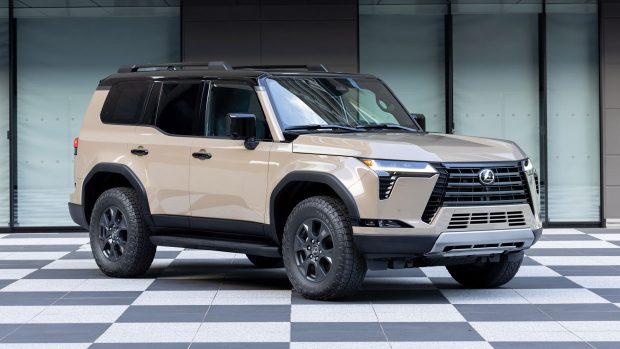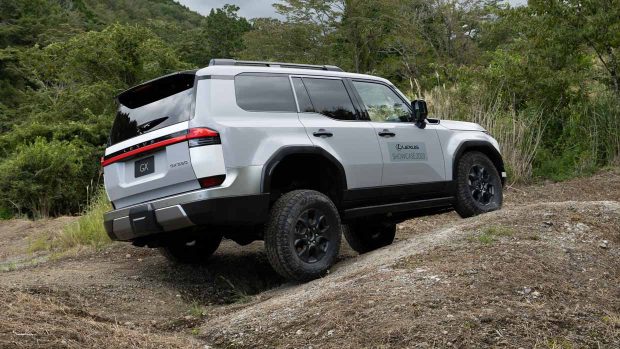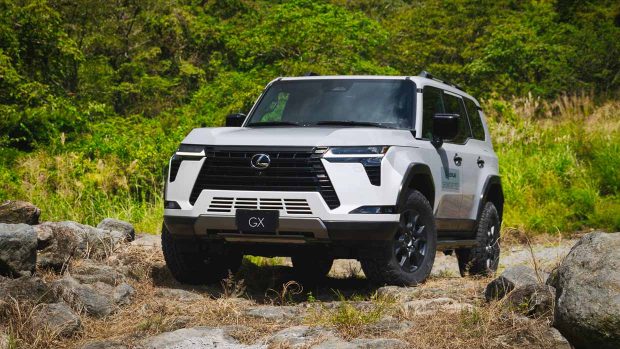-
Car Reviews
- All reviews
- Midsize SUVs
- Small cars
- Utes
- Small SUVs
- Large SUVs
- Large cars
- Sports SUVs
- Sports cars
- Vans
Latest reviews
- Car News
-
Car Comparisons
Latest comparisons
- Chasing Deals
Engineering work to enhance the water-resistance of the GX hybrid model is still ongoing for the turbo-hybrid four-cylinder option
The Toyota Prado-based Lexus GX four-wheel drive will be available only with a twin-turbo V6 petrol engine when it is released in Australia in the autumn of 2024.
While the confirmed GX550 model’s outputs of 260kW of power and 650Nm of torque from its force-fed bent-six are quite sufficient, a tantalising hybrid model has been developed – but it is not available to Lexus Australia yet.
A petrol-electric hybrid GX is in development and has already been confirmed for buyers in the United States, with the variant – likely badged GX500h – likely to be released in the American market in late 2024.
That engine, also used in the RX500h SUV, pairs a turbocharged 2.4-litre petrol four-cylinder with front and rear electric motors fed by a compact high-voltage lithium-ion battery mounted near the rear axle.
But additional strengthening work and durability testing is being conducted to ensure the hybrid GX is ready for heavier-duty markets – including Australia – with a particular focus on waterproofing the hybrid’s high-voltage battery.
Speaking with Chasing Cars at the global first drive of the petrol-only GX550, the model’s chief engineer Koji Tsukasaki explained what’s required to get the GX hybrid to Australia.
“[We are working on] the water resistance, especially the lithium-ion battery, because it rains a lot in Australia and people tend to drive a GX in water,” Tsukasaki said.
“We are ensuring the waterproofness of the [hybrid] battery.”
The petrol V6-equipped GX550 Overtrail grade, seen above, has ground clearance of 270mm – and it’s expected to match or exceed the 700mm wading depth limit of the previous-gen GX.
Tsukasaki wouldn’t be drawn on precisely when the waterproofing work on the GX hybrid would be completed, making the electrified GX ready for an Australian release.
“I can’t answer exactly how many years [it will take], but we want to release an adapted GX for regional needs as early as possible,” he said.
Half of the Lexus vehicles sold in Australia last year had hybrid engines.
The Japanese marque says it will offer an electrified option for each of its models in Australia by 2030, and Lexus has a global target to sell only full EVs by 2035.
Chasing Cars understands that the work being conducted to waterproof the GX hybrid’s high-voltage battery for Australian conditions is critical to the Toyota Motor Corporation’s preparations for introducing fully-electric off-road vehicles.
The GX chief engineer acknowledged that the TNGA-F body-on-frame platform utilised by the new GX and Prado – plus the existing LX and Land Cruiser – is being readied for full electrification.
“We built this platform so that our drivers can use it for a very long period of time – so we are emphasising using the same platform for further electrification at Lexus,” said Tsukasaki.
“We will be looking to the adoption of hybrid, plug-in hybrid and potentially a battery EV.”
Latest news
About Chasing cars
Chasing Cars reviews are 100% independent.
Because we are powered by Budget Direct Insurance, we don’t receive advertising or sales revenue from car manufacturers.
We’re truly independent – giving you Australia’s best car reviews.


